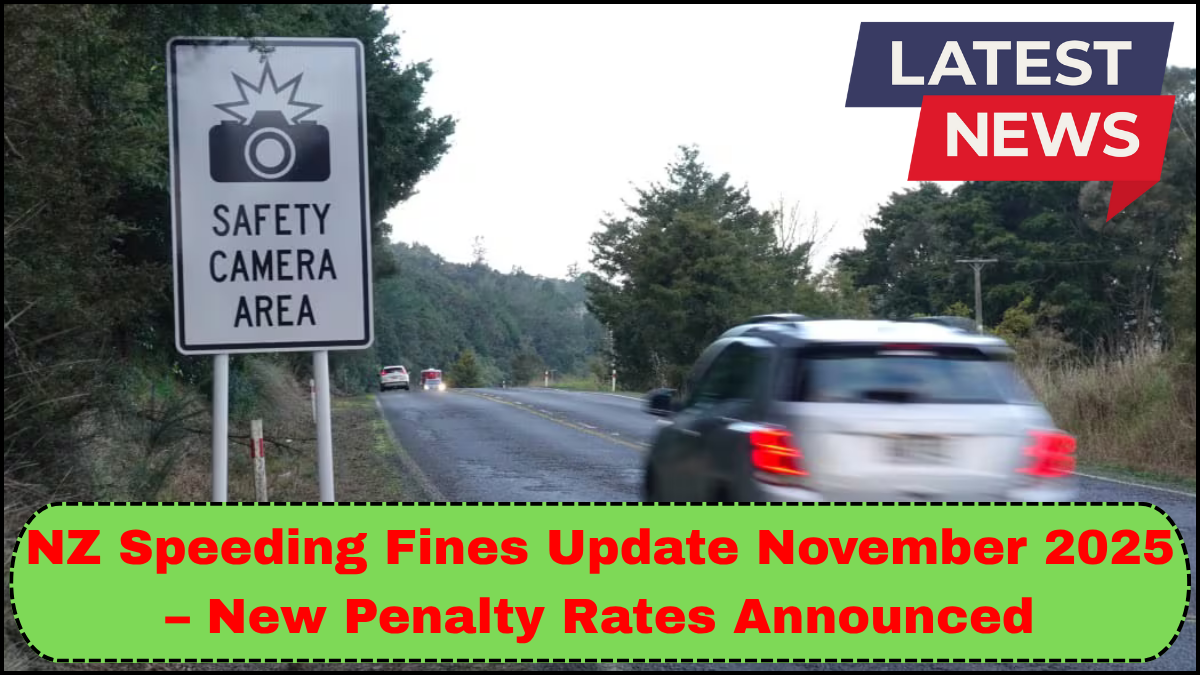In November 2025, the New Zealand Transport Agency (NZTA), in collaboration with the Ministry of Transport, rolled out significant updates to the country’s traffic penalty framework. The NZ speeding fines update November 2025 is part of a broader government strategy aimed at curbing road accidents, reducing repeat offences, and aligning penalty rates with the severity of infractions.
This latest move signals a tougher stance on speeding and other road violations, with new penalty rates structured to reflect both the level of danger posed and the need for deterrence. If you drive in New Zealand, understanding these changes is essential to avoid costly mistakes.

H3: Key Changes in the NZ Speeding Fines Update November 2025
The most notable change is the restructured fine brackets based on how far above the speed limit a driver is caught. Here’s a breakdown of the new penalty tiers introduced under the NZ speeding fines update November 2025:
-
1–10 km/h over the limit: Now carries a $60 fine (up from $30), with 10 demerit points.
-
11–20 km/h over the limit: Increased to $150 (previously $80), with 20 demerit points.
-
21–30 km/h over the limit: Fines jump to $320 (previously $170), with 35 demerit points.
-
31–40 km/h over the limit: Drivers face a $530 fine and 50 demerit points.
-
Over 40 km/h: This level is now treated as a serious offence, leading to an automatic court summons, a $1,000+ fine, and potential license suspension.
These fines now more accurately reflect the danger posed by excessive speed, particularly in urban and residential areas.
H3: Why the Changes? The Logic Behind the New Penalty Rates
New Zealand’s road safety record has fluctuated in recent years. With over 320 fatalities recorded in 2024 alone due to speed-related incidents, authorities identified a clear need to recalibrate enforcement measures.
The new penalty rates are designed to do more than just punish. They serve as a preventive measure to slow drivers down before tragedy strikes. According to Transport Minister Kiri Allen, the goal is to “build a culture of responsibility, not just reaction.”
In addition, rising costs related to accident response and insurance claims have pushed policymakers to reconsider how traffic fines in NZ are structured. Higher penalties are expected to reduce repeat offending and help fund education campaigns and improved enforcement technology.
H3: Targeting High-Risk Zones and Repeat Offenders
The 2025 update also introduces location-based fine modifiers. Speeding in school zones, near pedestrian crossings, or in construction areas will now result in an additional 25% increase in base fines.
Repeat offenders face escalated consequences. Those caught speeding more than three times within a 12-month period will be flagged for mandatory defensive driving courses and may face immediate license suspension pending a review.
Police also announced expanded use of speed detection technologies such as fixed cameras, average speed cameras, and mobile patrols, especially during high-risk periods like holidays and long weekends.
H3: Demerit Points and License Suspension Rules Tightened
Demerit points remain a critical part of New Zealand’s driver accountability system. Under the updated framework:
-
Accumulating 100 demerit points within two years results in an automatic 3-month license suspension.
-
Drivers with 80 points or more may be referred for a mandatory review before reaching the full limit.
These thresholds have not changed, but the speed at which they can be reached has significantly increased due to the higher points associated with new fine levels.
H3: Implications for International Drivers and Rental Vehicle Users
The update also includes stricter protocols for international license holders and those driving rental cars. Rental agencies must now notify foreign drivers of New Zealand’s traffic fines system and updated penalties before vehicle handover.
Fines can now be enforced through international agreements, meaning unpaid penalties may follow drivers beyond their stay. The government is also working with rental companies to flag frequent violations and ban repeat offenders from future rentals.
H3: Conclusion – Drive Smarter, Not Faster
The NZ speeding fines update November 2025 isn’t just about higher numbers. It reflects a shift in how New Zealand views road safety—emphasizing deterrence, accountability, and proactive behavior change. Whether you’re a local or a visitor, staying informed and adjusting your driving habits is crucial.
The message is simple: follow the rules, respect the limits, and help make New Zealand’s roads safer for everyone.
Frequently Asked Questions (FAQs)
Q1: When did the new speeding fines take effect?
A: The updated fines came into effect on November 1, 2025, across all regions in New Zealand.
Q2: Do the new penalty rates apply to all types of vehicles?
A: Yes, the changes apply to all drivers, including those operating private cars, commercial vehicles, motorcycles, and rental cars.
Q3: How can I check how many demerit points I have?
A: You can check your demerit point status through the NZTA online portal or by contacting their customer service.
Q4: Are there payment plans available for large fines?
A: In some cases, yes. You may apply for an installment arrangement through the Ministry of Justice’s fines management system.
Q5: What should I do if I believe I was wrongly fined?
A: You can contest the fine by submitting a dispute form via the Infringement Notice portal within 28 days of the notice being issued.
click here to learn more